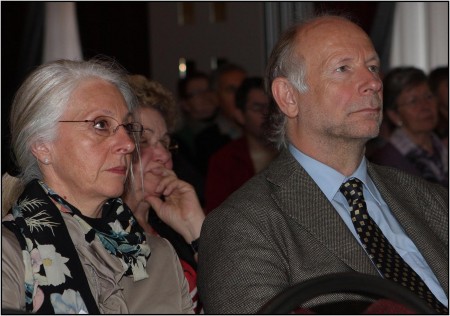 About 80 GIST patients, relatives, GIST experts, interested professionals, physicians and representatives of the pharmaceutical industry gathered at the Restaurant Au Premier at Zurich Main Station in Zurich on April 8 for the ninth meeting of the Swiss GIST group. A warm welcome was extended to special guests Candy Heberlein, President of the Swiss Foundation for the Promotion of Bone Marrow Transplantation, and Christel Jäger-Freysoldt, chief executive of Das Lebenshaus in Germany.
About 80 GIST patients, relatives, GIST experts, interested professionals, physicians and representatives of the pharmaceutical industry gathered at the Restaurant Au Premier at Zurich Main Station in Zurich on April 8 for the ninth meeting of the Swiss GIST group. A warm welcome was extended to special guests Candy Heberlein, President of the Swiss Foundation for the Promotion of Bone Marrow Transplantation, and Christel Jäger-Freysoldt, chief executive of Das Lebenshaus in Germany.
Representatives from Bayer, Bristol-Myers Squibb, Novartis and Pfizer Pharmaceuticals were also present. As always, it was a unique opportunity for the participants to learn about the latest insight into GIST and its treatment, as well as to meet experts in this field. Markus Wartenberg from Das Lebenshaus moderated the meeting.
The meeting was opened by the president of the Swiss GIST group, Martin Wettstein. Firstly, our two deceased regional managers, Matthias Merki of the Northwest Switzerland regional support group, and Herbert Blatter of the Romandie regional support group, were remembered by a minute’s silence. Matthias Merki passed away on August 6, 2011, in the Hospital St Clara in Basel. Herbert Blatter lost his fight against GIST on March 6, 2012, in the Center Hospitalier Universitaire Vaudois (CHUV), Lausanne. Matthias Merki’s tasks will be taken over by Martina Kuoni, and Gisèle Möri and Audrey Mathot will be responsible for West Switzerland. Martin Wettstein thanked the new regional managers for their willingness in taking over these tasks.
The topic of GIST was handled in two parts with cutting-edge presentations from two international GIST specialists, Dr. Michael Montemurro and Dr. Sebastian Bauer.
Dr. Montemurro, consultant at the CHUV in Lausanne and medical adviser to the Swiss GIST group, introduced the first part. Dr. Montemurro provided all participants – and notably those who were attending the meeting for the first time – with basic knowledge of GIST. He also talked about “GIST 2012: State of the Art in the Research and Treatment for GIST.”
Dr. Sebastian Bauer of the University of Essen in Germany, as well as the LRG Research Team, then gave a report on “Future GIST Treatment.” These two presentations conveyed a great deal of hope, after all, several new and effective substances are at the testing stage or will be within reach for GIST patients. The result of the 2012 American Society of Clinical Oncology (ASCO) convention in Chicago at the beginning of June is keenly awaited because data related to regorafenib in GIST will likely be available then.
The third presentation was by Dr. Gilles Allenbach, consultant at the CHUV. His topic was “How does PET (Positron Emission Tomography) function?” Dr. Allenbach not only explained the functioning of PET scans, but also all the related important preparatory operations. Dr. Francis Verdun, CHUV, then spoke on the topic of radiation exposure resulting from various types of imaging. This provided a profound insight into the world of measurement of radiation to the participants.
A particular approach in the sector of surgery was taken by Dr. Christoph Kettelhack from the University Hospital in Basel in his presentation on “Selecting the Right Time to Operate.” By means of a patient case study coupled with impressive pictures, he explained when how neoadjuvant therapy (given before a GIST operation) can greatly reduce surgical risks.
A very current topic – though not yet so familiar in Switzerland or in the GIST community – is the role and task of the Oncological Nursing organization in Switzerland (Onkologiepflege Schweiz/Soins en Oncologie Suisse). Ms. Anita Margulies gave an understanding of this in her presentation. Unlike in other countries, the topic of the task and/or involvement of nursing staff in oncology is not yet established in Switzerland. The final presentation was made by Martina Kuoni, regional manager of Northwest Switzerland, literary scholar and GIST patient. In her uplifting talk on “sickness in literature” with the aid of amusing literary extracts.



